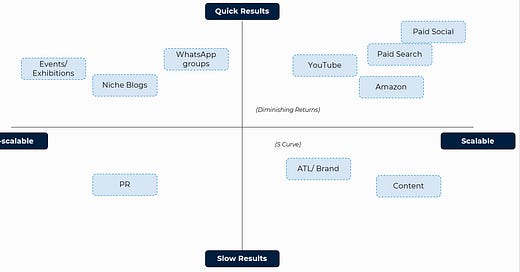Whether you are building an app or a facewash or a protein bar, acquiring new customers remain one of the toughest challenges
And with a plethora of customer acquisition channels( basically all marketing activities are some form of customer acquisition), it seems very complex
Now, if I were to make a list of activities that we have done over the last 10 years to acquire customers/generate demand, it would look something like this
- Society Activations
- Exhibitions
- Partnering with a Niche Website called Bijlibachao
- Part of Forums of Energy Auditors
- Facebook Ads
- Google Ads
- Activations in Offline Electrical Shops
- Large Scale TV/OOH/ATL Campaigns
- E-Commerce Ads
- Electrician Tie Ups
- PR
- Organic Social Content
- Sponsorships
- Influencer Marketing
- SEO
If I were to classify all customer acquisition activities, I can actually classify them in a 2*2 with the two dimensions being Scalability (If money isn’t a constraint, can I spend more and get more customers to buy) and Time to Results ( some give immediate results, some take time)
This is what it would look like
There are some channels where if you have money, you can quickly scale. Of course any channel that can be scaled quickly also sees diminishing returns as you spend more and more on that channel. Amazon ads, Google/FB etcs are classic examples of such channels.
Then you have channels which take time to scale. Content and SEO are perfect examples of this. They don’t give immediate results, but if done well, pays off massively in the long run. They follow a classic S-Curve when it comes to results vs efforts
And then of course you have unscalable channels. They sometimes give good results, but very difficult to scale. A society activation can give you good quick trials, but it is impossible to do it in every housing society at a cost that makes sense. Same for niche blogs/sites etc. There just aren’t enough of them for it to be a scalable channel
And this has massive implications in the acquisition channel mix and how it should evolve with time as the brand scales
We can divide the scale of the brand in 4 parts
- 0 to 1
- 1 to 10
- 10 to 100
- 100+
In the 0 to 1 bit, the emphasis should be figure out PMF. And if it means you need to use unscalable channels, so be it. An ideal channel mix would be few unscalable channels( better ROI, quicker feedback) and maybe few scalable quick result channels( typically what we call performance marketing).
As the brand gets early signs of PMF, in the 1-10 phase, it is extremely important to nail down 1 scalable acquisition channel and go deep into it. If you can nail down 2, nothing like it. For new age food brands, maybe it will be Quick commerce ads and Meta ads. For new age mattress brands, maybe it will be Google and Amazon ads
Once you establish PMF and nail down one channel and scaling well and move to the 10-100 phase, now is the time to start investing good amount of resources in slow result scalable channels. And this is a mistake that most startups brand. While growth is happening through quick result diminishing returns scalable channels( aka performance marketing), brands think that this growth will keep continuing and they don’t invest enough in other channels. And suddenly growth stops/keeps getting more expensive.
And then brands panic and try to invest in other slow but scalable channels. But these channels are slow and don’t give immediate results. And when growth stalls, brands are panicking and need quick results and don’t have patience and invariably make a wrong conclusion that content/SEO/TV etc don’t work for them
On the other hand, if brands start investing in these channels when they don’t need immediate sales from these channels, the slow scalable channels get fully ready to acquire new customers at scale by the time the performance marketing channels hit diminishing returns
And lastly, at the 100+ scale, brands have a good mix of all acquisition channels. The reliance on performance marketing keeps reducing as the other slow scalable channels hit full potential.
But the biggest takeaway is in the 0-1 phase you should be okay to have unscalable channels. Paul Graham and YC were always right with their “Do things that don’t scale”. In the next phase, nail down at least 1 fast scalable acquisition channel. And once that happens, start investing in the slow but scalable channels so that they are ready for results before the fast scalable channels hit diminishing returns
The challenge in all of this is to identify the right timing for each and to understand where you in the journey are. But then again, that is what founders have to get right to build large sustainable brands from scratch





Arindam, would love to hear from you about a tracking model that gives a rough estimate of how deep have we penetrated into in-market audience in a category. Having the moving trend of this may help us answer the timing part as to when do we start investing in slow but scalable acquisition channels. Makes sense?
Hi Arindam,
Can you clarify something - as per the chart it looks like ATL is not scalable as compared to digital channels, why do you think so?
Also diminishing returns would apply in both ATL and the digital channels right? (I get it the diminishing returns will be faster in digital as it's scalable quicker, but if money is not a constraint I think even ATL is highly scalable quickly, but results will be slower)